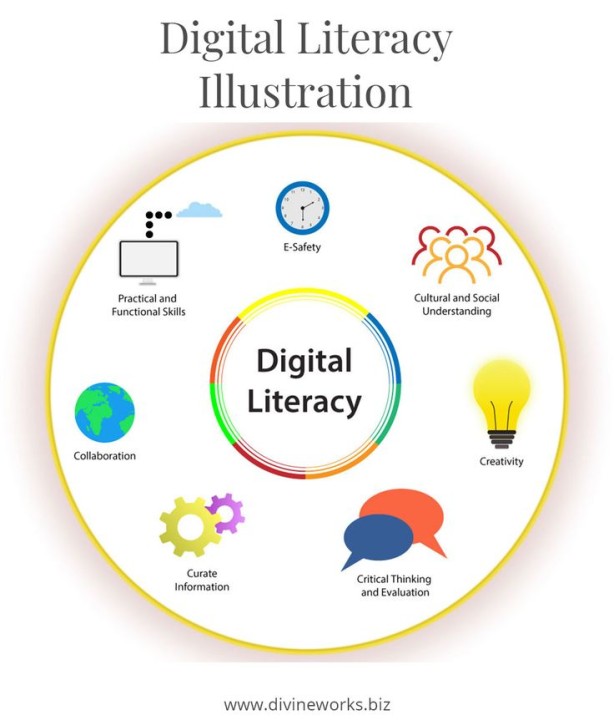Introduction
Each day, cutting-edge information technologies provide us with new ways of tackling challenges in and outside our classrooms. Along with these rapid enhancements and solutions comes the challenge of staying up to date with current developments.
In a digitally enriched world where messaging apps and social networks have replaced face-to-face communication, where collaboration happens in real-time and online, and information is obtained via digital libraries, vlogs, and video content, digital literacy is becoming a fundamental skill to promote through our courses.
What is digital literacy?
While there is a plethora of definitions for digital literacy, it can be defined as “the ability to use information and communication technologies to find, evaluate, create, and communicate information, requiring both cognitive and technical skills” (National Digital Inclusion Alliance). Digital literacy in the classroom comprises a set of skills that allow students to use digital technologies to obtain and evaluate information, solve problems, complete assignments, and create content.
How can teachers in humanities promote digital literacy and digital citizenship as they assist students in developing essential skills such as communicative and collaborative abilities, critical and analytic thinking, creativity, and social responsibility?
Here are five ways to foster these skills while incorporating digital literacy into your classes.
- Enhance media literacy
One of the vital skills in digital literacy is the ability to tell fact from fiction and become conscientious and critical users of information resources. To encourage this, you can have students analyze different pieces of information, provide a critical reading of an op-ed article on history, analyze a blog post on ethics or complete a fact-checking assignment for a news piece. To further aid students, you can provide them with media literacy toolkits or organize workshops on detecting misinformation, decoding media messages, fact-checking, or the ethical use of online resources. Additionally, class discussions on digital literacy can revolve around how certain media outlets can empower different groups of people or vice versa. And this takes us to our next point: digital equity.
- Advocate for digital equity
Apart from the skillful use of digital resources, digital literacy also implies students’ awareness of the digital divide and how each of us can contribute to digital equity. The National Digital Inclusion Alliance defines digital literacy as “a condition in which all individuals and communities have the information technology capacity needed for full participation in our society, democracy, and economy. Digital equity is necessary for civic and cultural participation, employment, lifelong learning, and access to essential service.” For your classes, you can create opportunities for students to research digital equity in their community, complete research assignments on how digital inequity affects certain groups, find ways to advocate for digital equity and amplify stories by and about underrepresented groups. Whether teaching history, literature, or cultural studies, have students consider how histories and stories of underrepresented people are being told and disseminated in today’s digital landscapes.
- Encourage digital storytelling
Another way to develop digital literacy in students is to encourage and empower them to become creators. Digital storytelling can be an excellent tool for this. It will not only support students in putting their creativity to work but will foster 21st-century skills. This way, students will become more aware of the intricacies of creating a digital piece of information and ask important questions: What responsibilities do creators have? How do our stories and voice influence and empower people?
Students can hone their digital storytelling skills by creating video essays or presentations through digital tools such as Sutori. You can incorporate digital storytelling into a wide range of humanities classes from Creative Writing to Arabic and Classics. Here’s an excellent list of digital storytelling resources put together by the University of Wollongong in Australia.
- Assign multimedia research projects
Switch the traditional final research paper assignment with a multimedia research project where students can critically examine and analyze multimedia pieces related to the topic they want to explore in their final paper. This assignment will not only engage students more creatively but will allow them to share their work with classmates or the entire school via a class blog, for instance. A digital research project will also encourage students to think broadly, interact with a variety of digital tools, and foster interdisciplinary connections. For instance, a final project for a history or literature class could focus on the baroque art movement in music, literature, and painting and have embedded links to podcast episodes, music videos, online galleries, photographs, and other resources exploring this topic.
- Foster online communication and collaboration
Good communication and online collaboration play a vital role in an increasingly digital world. Yet, the online space can be an intimidating and unsafe environment for many, so it is important to educate future citizens who are equipped with the skills and awareness to contribute to the creation of safer online spaces. Whether you are teaching online or face-to-face, consider creating online debates or discussions using your LMS to allow students to practice safe and respectful interactions with diverse opinions and ways of thinking in an online environment. After the assignment, guide students to reflect on the challenges of communicating and collaborating in online space and the tools they used to communicate respectfully and effectively. Make sure you share and discuss netiquette rules with your students before assigning the activity.
Conclusion
Digital technologies will continue evolving and intersecting with every area of our life and work. To set up our students for success in this digitally driven world, we need to aid them in becoming digitally literate and active contributors to a more democratic, ethical, and safe digital environment.

